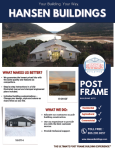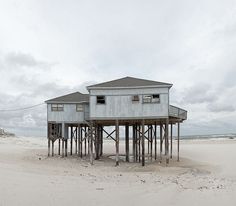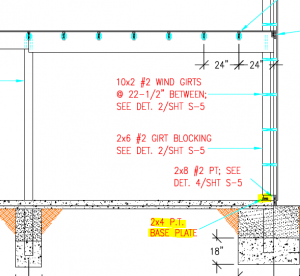This Wednesday the Pole Barn Guru answers reader questions about the design of a small living space with everything together in one room, whether or not one can use existing posts that are still standing in the aftermath of Hurricane Helene, and a reader asks why we don’t post prices of past projects on our website.
 DEAR POLE BARN GURU: I want a 1 room with very small sitting area, a bed area a kitchen very small and a walk in shower toilet and water basin all together in one room. LISA in ALMA
DEAR POLE BARN GURU: I want a 1 room with very small sitting area, a bed area a kitchen very small and a walk in shower toilet and water basin all together in one room. LISA in ALMA
DEAR LISA: Our Design Team can certainly craft a building solution to best meet your wants and needs. Please reach out to Megan on her direct line: 605.432.8987 on Monday to discuss further.
DEAR POLE BARN GURU: I lost my house in the Florida big bend due to Storm Surge from Helene. My house was on 8×8 posts on 8 foot centers. The house is gone but posts are still standing. They are 10 feet high. My question can I install the pole barn on my existing posts. The dimensions are basically 32′ by 32′ and again are 10 feet high. If so what do I need to do to give it as much strength as possible. Thanks, RICHARD in PERRY
 DEAR RICHARD: Sorry for your loss of your home, has to have been devastating. Could and should are our operative words here. I first experienced stilt houses when visiting Kitty Hawk (https://www.hansenpolebuildings.com/2014/11/kitty-hawk/). As you have experienced first-hand what happens when a “hinge” point is created between columns and home above, even though you could use your existing columns, I would strongly encourage their being removed and replaced with columns long enough to run full height up to eave line. If your now gone home had been engineered this way, it is highly unlikely we would be having this exchange today. Our Design Team can work with you to craft a new home, able to withstand even storms like Helene.
DEAR RICHARD: Sorry for your loss of your home, has to have been devastating. Could and should are our operative words here. I first experienced stilt houses when visiting Kitty Hawk (https://www.hansenpolebuildings.com/2014/11/kitty-hawk/). As you have experienced first-hand what happens when a “hinge” point is created between columns and home above, even though you could use your existing columns, I would strongly encourage their being removed and replaced with columns long enough to run full height up to eave line. If your now gone home had been engineered this way, it is highly unlikely we would be having this exchange today. Our Design Team can work with you to craft a new home, able to withstand even storms like Helene.
![]() DEAR POLE BARN GURU: Looking at your project # and photos, why can’t you have prices of how much these costed customers/projected. I don’t really care to speak to someone as I’m preparing my first pole barn project but I want to get an idea of what I want to install on our property. Very frustrating and I’ve found one builder who proves are listed making my purchase 10x easier to plan for… RICHARD in SPOKANE
DEAR POLE BARN GURU: Looking at your project # and photos, why can’t you have prices of how much these costed customers/projected. I don’t really care to speak to someone as I’m preparing my first pole barn project but I want to get an idea of what I want to install on our property. Very frustrating and I’ve found one builder who proves are listed making my purchase 10x easier to plan for… RICHARD in SPOKANE
DEAR RICHARD: Our intent is certainly not to frustrate. We could post what our clients paid at time they ordered, however those prices would only be reflective of material costs at one particular point in time. During COVID prices escalated dramatically and have since eased, so brief snippets from before or during would not give you an accurate price. We also provide buildings in all 50 states – so design loads can vary greatly. We have engineered for design wind speeds in excess of 200mph, buildings with full exposure to winds off large bodies of water and snow loads over 400psf. Outside of all of these, since we opened our wholesale lumber business and prefabricated wood truss facility this year, our materials costs have dropped exponentially, however shipping to Iowa is going to be less costly than shipping to Washington (as an example).
Our Building Design team will happily provide you with an exact and current price for your location. All we need is for you to please email our Project number, site address and best contact number to our Design Studio Manager Caleb@HansenPoleBuildings.com 1.866.200.9657 Thank you.
 DEAR POLE BARN GURU: Do you have a kit that can be used in a flood area to raise floor about 10 feet. RAY in HOUSTON
DEAR POLE BARN GURU: Do you have a kit that can be used in a flood area to raise floor about 10 feet. RAY in HOUSTON DEAR WILL: Congratulations upon considering post frame construction as your structural design solution. Sadly, most kit providers and builders are selling building shells based upon cheapest price, rather than meeting their client’s needs. With this low price, most often comes what is known as externally mounted wall girts – wall framing to support siding being attached wide face to wind on outside of columns. While this is quick, easy and takes little thought, it rarely meets Building Code requirements for meeting deflection criteria. There is a way to solve wall framing to be a one step process – bookshelf wall girts every 24 inches. This creates a very stiff wall structurally, provides an insulation cavity and requires no extra framing to add interior finishes.
DEAR WILL: Congratulations upon considering post frame construction as your structural design solution. Sadly, most kit providers and builders are selling building shells based upon cheapest price, rather than meeting their client’s needs. With this low price, most often comes what is known as externally mounted wall girts – wall framing to support siding being attached wide face to wind on outside of columns. While this is quick, easy and takes little thought, it rarely meets Building Code requirements for meeting deflection criteria. There is a way to solve wall framing to be a one step process – bookshelf wall girts every 24 inches. This creates a very stiff wall structurally, provides an insulation cavity and requires no extra framing to add interior finishes. DEAR STEVE: If you place a 2×4 vertically in a hole and push downward on it and it just keeps sinking, you have a challenge going on. Your best solution then is going to be to hire a geotechnical engineer to visit your site and do a determination of how to adequately support your building based upon actual soil conditions. It may be able to be solved by use of larger diameter footings, or use of rebar within your slab (tied to columns), piers down to solid bedrock or some combination of these. Your building will only be as strong as your foundation, so this is not a place to mess around or guess.
DEAR STEVE: If you place a 2×4 vertically in a hole and push downward on it and it just keeps sinking, you have a challenge going on. Your best solution then is going to be to hire a geotechnical engineer to visit your site and do a determination of how to adequately support your building based upon actual soil conditions. It may be able to be solved by use of larger diameter footings, or use of rebar within your slab (tied to columns), piers down to solid bedrock or some combination of these. Your building will only be as strong as your foundation, so this is not a place to mess around or guess.





